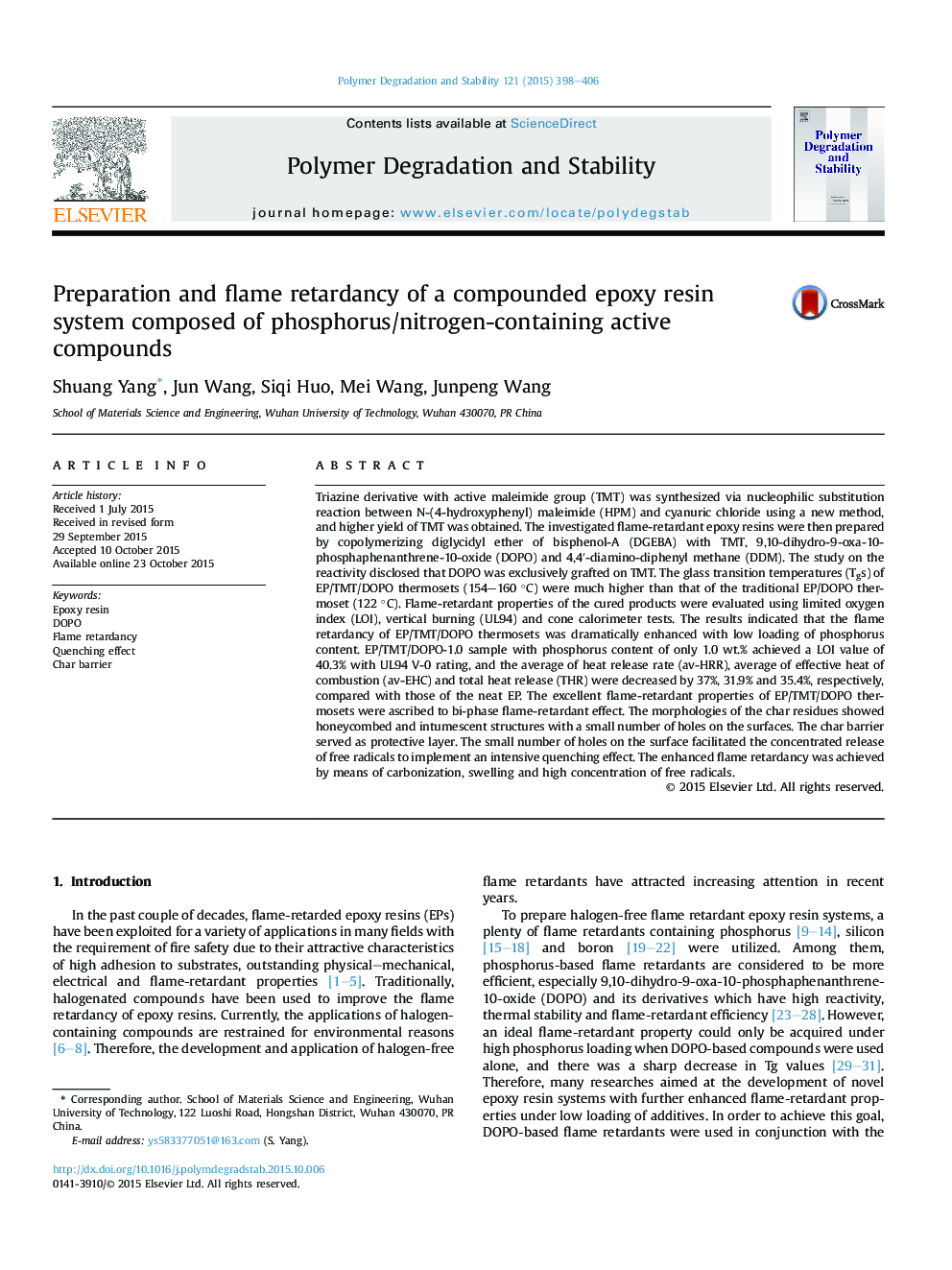| کد مقاله | کد نشریه | سال انتشار | مقاله انگلیسی | نسخه تمام متن |
|---|---|---|---|---|
| 5201402 | 1502892 | 2015 | 9 صفحه PDF | دانلود رایگان |
عنوان انگلیسی مقاله ISI
Preparation and flame retardancy of a compounded epoxy resin system composed of phosphorus/nitrogen-containing active compounds
ترجمه فارسی عنوان
آماده سازی و بازدارندگی شعله یک سیستم رزین اپوکسی ترکیبی از ترکیبات فعال فسفر / نیتروژن
دانلود مقاله + سفارش ترجمه
دانلود مقاله ISI انگلیسی
رایگان برای ایرانیان
کلمات کلیدی
موضوعات مرتبط
مهندسی و علوم پایه
شیمی
شیمی آلی
چکیده انگلیسی
Triazine derivative with active maleimide group (TMT) was synthesized via nucleophilic substitution reaction between N-(4-hydroxyphenyl) maleimide (HPM) and cyanuric chloride using a new method, and higher yield of TMT was obtained. The investigated flame-retardant epoxy resins were then prepared by copolymerizing diglycidyl ether of bisphenol-A (DGEBA) with TMT, 9,10-dihydro-9-oxa-10-phosphaphenanthrene-10-oxide (DOPO) and 4,4ʹ-diamino-diphenyl methane (DDM). The study on the reactivity disclosed that DOPO was exclusively grafted on TMT. The glass transition temperatures (Tgs) of EP/TMT/DOPO thermosets (154-160 °C) were much higher than that of the traditional EP/DOPO thermoset (122 °C). Flame-retardant properties of the cured products were evaluated using limited oxygen index (LOI), vertical burning (UL94) and cone calorimeter tests. The results indicated that the flame retardancy of EP/TMT/DOPO thermosets was dramatically enhanced with low loading of phosphorus content. EP/TMT/DOPO-1.0 sample with phosphorus content of only 1.0 wt.% achieved a LOI value of 40.3% with UL94 V-0 rating, and the average of heat release rate (av-HRR), average of effective heat of combustion (av-EHC) and total heat release (THR) were decreased by 37%, 31.9% and 35.4%, respectively, compared with those of the neat EP. The excellent flame-retardant properties of EP/TMT/DOPO thermosets were ascribed to bi-phase flame-retardant effect. The morphologies of the char residues showed honeycombed and intumescent structures with a small number of holes on the surfaces. The char barrier served as protective layer. The small number of holes on the surface facilitated the concentrated release of free radicals to implement an intensive quenching effect. The enhanced flame retardancy was achieved by means of carbonization, swelling and high concentration of free radicals.
ناشر
Database: Elsevier - ScienceDirect (ساینس دایرکت)
Journal: Polymer Degradation and Stability - Volume 121, November 2015, Pages 398-406
Journal: Polymer Degradation and Stability - Volume 121, November 2015, Pages 398-406
نویسندگان
Shuang Yang, Jun Wang, Siqi Huo, Mei Wang, Junpeng Wang,
